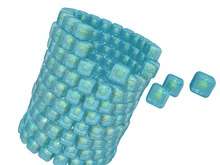Micromasonry
Micromasonry is a fabrication technique to self-assemble micrometric and sub-micrometric three-dimensional units into larger structures.[1] The technique is based on the self-assembly construction and hierarchical design of biological materials.

It was developed by Spanish materials scientist Javier G. Fernandez of the Massachusetts Institute of Technology to produce artificial organs by self-assembling groups of biological cells in biocompatible polymers. This method allows the self-assembly of encapsulated cells in 3D geometries, enabling the fabrication of biological tissue following an approach similar to building a brick structure. Because this bottom-up method of fabrication, the resulting constructions are some times referred as "bio-Legos".[2]
Micromasonry is considered an important breakthrough in fabrication for modern tissue engineering,[3] for its simplicity, efficiency, and for being the major example in the merge of microelectronic engineering techniques and biological functionality.[4]
Since its development, micromasonry has been extensively employed for the construction of cell-laden organ replacements and 3D microelectronics.[5]
Terminology
Micromasonry is often referred as "bio-legos" or "biological legos" because its extensive use for the construction of biological tissue.
References
- ↑ Trafton, Anne (2010). Building organs block by block. MIT News
- ↑ Schott, Ben (2010) Micromasonry & Biological Lego. The New York Times
- ↑ Armstrong Moore, Elizabeth (2010). Breakthrough in tissue engineering: 'Bio-Legos'. CNET
- ↑ Wolfson, Wendy (2010). Human Lego may one day build artificial organs. New Scientist
- ↑ Keum, Hohyun (2012). Silicon micro-masonry using elastomeric stamps for three-dimensional microfabrication. J.Micromech.Microeng